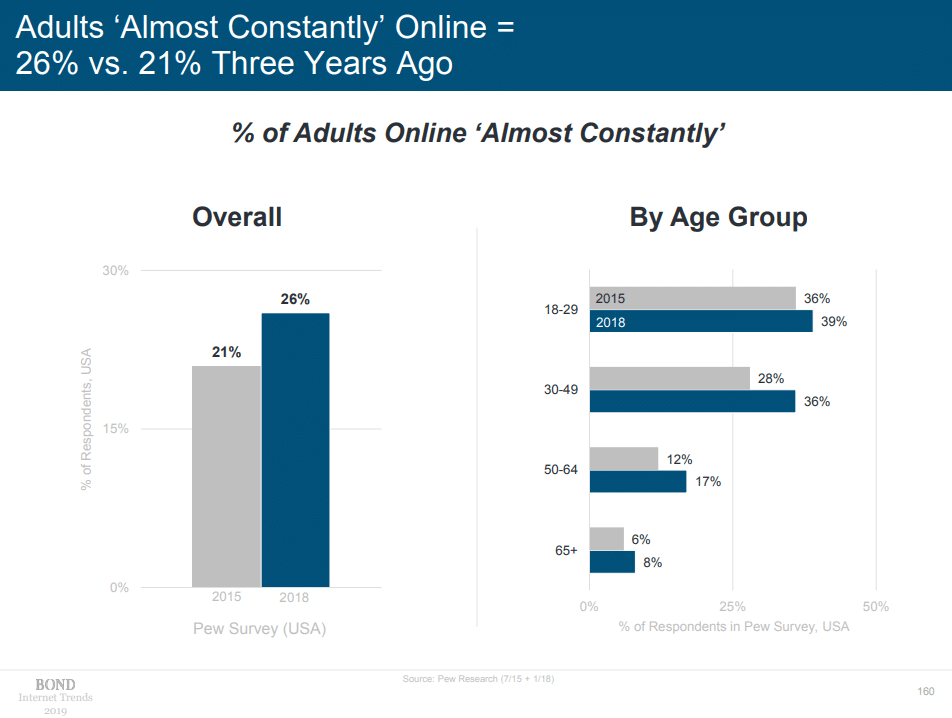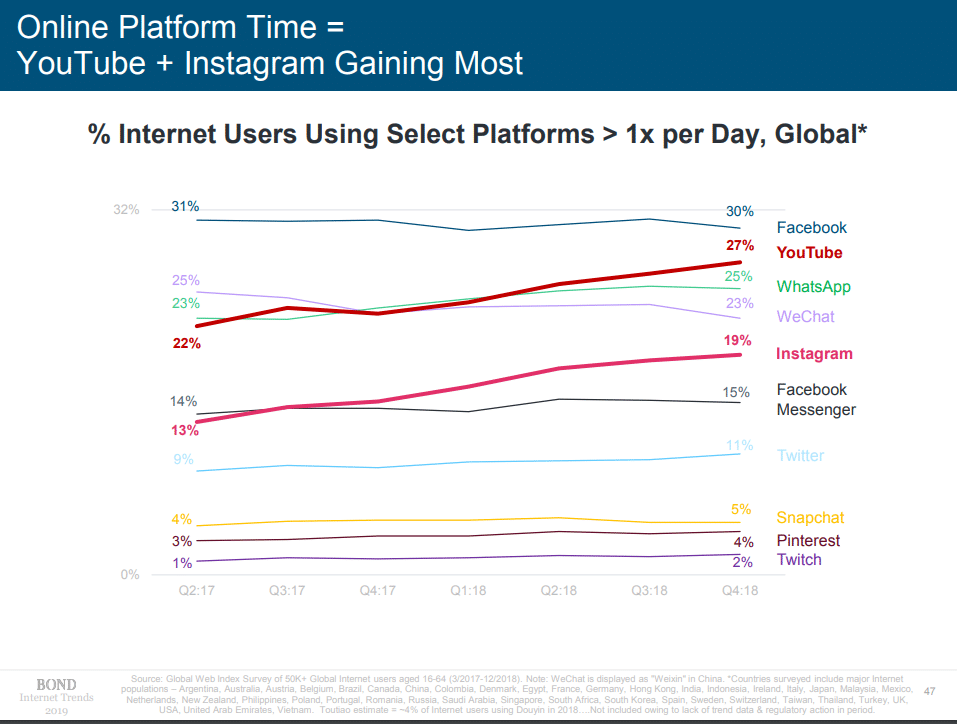Key takeaways from Mary Meeker’s 2019 Internet Trends report
16/07/19
4'
Dubbed “Queen of the Net”, the famous analyst Mary Meeker released the 2019 edition of her annual report on internet trends in June. The 333-page slide deck details key figures and looks at where society globally stands today in subjects such as tech, advertising and consumer behaviour.
51% of the world is connected
Around the globe, the internet is now a part of our daily routine. The majority of the world – by 1% – is now connected with 3.8 billion people using the internet. New internet users are hard to find in the Western hemisphere. Asia Pacific accounts for 53% of internet users; China making up 21% of the share. Along with Africa, Asia Pacific still offers huge growth potential, as both regions have less than 50% user penetration; these emerging e-commerce markets should be watched for new opportunities.

Mobile is King
Americans spent an average of 6.3 hours/day on the internet in 2018, mostly on mobile devices. 26% of adults are almost always online – spearheaded by the ever-increasing importance of mobile devices.

Marketers understand this importance, as spending on print, TV and radio ads has fallen. In the US, mobile accounted for 33% of time spent on digital media and 33% of advertising spend – we see the same equal split for television (34% time spent/34% advertising spend) and desktop (18% time spent/18% advertising spend).

For the first time, time spent on mobile has surpassed time spent watching TV in the US. A 2019 estimate suggests that adults spent an average of 226 minutes (more than 3.5 hours) on their phones compared to 216 minutes in front of the TV. However, globally, sales of smartphones are declining at -4%. Why is that? A logical explanation would be that almost everyone has already got one.
Mary Meeker highlights that digital-based TV ads aided by in-hand mobiles are an opportunity to be watched, as multi-platform data can help to improve the relevancy of advertisements. 88% of US consumers use a second device while watching TV and 71% look up content related to what they’re watching. This is illustrated by the fast-fashion retailers Missguided’s partnership with the popular reality show Love Island in 2018. Missguided provided clothes for contestants and allowed viewers to shop for them via the show’s official app. This partnership boosted Missguided sales by 40% compared with the eight weeks prior to when the show started airing; some items worn by popular contestants would see an instant 500% sales bump.

E-Commerce growth is solid, but slowing
E-commerce now accounts for 15% of retail sales in the US, compared with 14% a year earlier. E-commerce growth has slowed over recent years, nonetheless, the market is up 12.4% in Q1 compared with a year earlier. This figure still towers above that in brick-and-mortar retail, which was growing, but just at 2% in Q1.
Today, tech companies reign in importance, claiming 7/10 of the world’s most valuable companies (by market cap). This includes marketplaces Amazon, Facebook and Alibaba. Cross-border trade makes up 29% of global GDP, which is heavily influenced by these giant marketplaces.
Paving the way for social commerce
Meeker also highlights the growth of social commerce. ‘Shopability’ is increasingly integrated into social platforms, helping e-commerce to reach new communities and demographics while smoothing the customer journey by allowing e-shoppers to make purchases without exiting their favourite app.
Instagram, the app which gained the most share in time spent on digital platforms from previous years (+6%), recently released its new feature Instagram Checkout. The feature provides invaluable product marketing opportunities for retailers by allowing allows users to shop directly from brands and a personalised and targeted shopping experience for consumers.

Facebook is also slowly rolling out a new payment functionality in the messaging app WhatsApp, first trialled in India, May 2018, and next set to be launched in Europe, with London as the focus point. This is particularly pertinent when taking into consideration today 59% of payments are digital.

New social platforms are entering the mix; Meeker specifically highlights video game Fortnite as being increasingly similar to a social network. 250 million active users, most of which aged between 18 and 24, are able to make in-game purchases with ‘V-Bucks’ and attend in-game events such as the concert held by DJ Marshmello (attended by +10 million users). With this level of exposure, Fortnite demonstrates itself as an important new marketing channel, and undoubtedly a new channel to be watched…
Discover the full report “Internet Trends 2019” by Mary Meeker (Bond)
Image: Kleiner Perkins
Your e-commerce library
Sign up for our newsletter
By submitting this form you authorize Lengow to process your data for the purpose of sending you Lengow newsletters . You have the right to access, rectify and delete this data, to oppose its processing, to limit its use, to render it portable and to define the guidelines relating to its fate in the event of death. You can exercise these rights at any time by writing to dpo@lengow.com

Trending Posts
Marketing channels
ChatGPT Ads and advertising on GenAI Search Engines: what you need to know
Advertising on generative AI-based search engines (GenAI) marks a new era in digital marketing. After two decades dominated by traditional…
22/05/25
6'
Marketing channels
Reddit and Social Commerce: When Users Take Back Control
Before buying anything, we compare. We hesitate. And more and more often, we end up typing the product name followed…
30/06/25
8'
Marketing channels
How to Sell on TikTok in 2025: The Ultimate Guide to Success
To sell or not to sell on TikTok? That remains a question many brands ask themselves. But here’s what you…
03/02/25
7'
E-commerce Trends
E-Commerce 2025: The New Rules of Digital Retail
What’s going on in e-commerce? A lot. If 2024 was the year brands got comfortable with marketplaces, AI tools, and…
11/07/25
8'
Marketing channels
Omnichannel Strategy: The Best Examples of Successful Brands
Consumers interact with brands through multiple channels, including online, in-store, and mobile apps. More than 90% of consumers expect a…
04/04/25
5'




